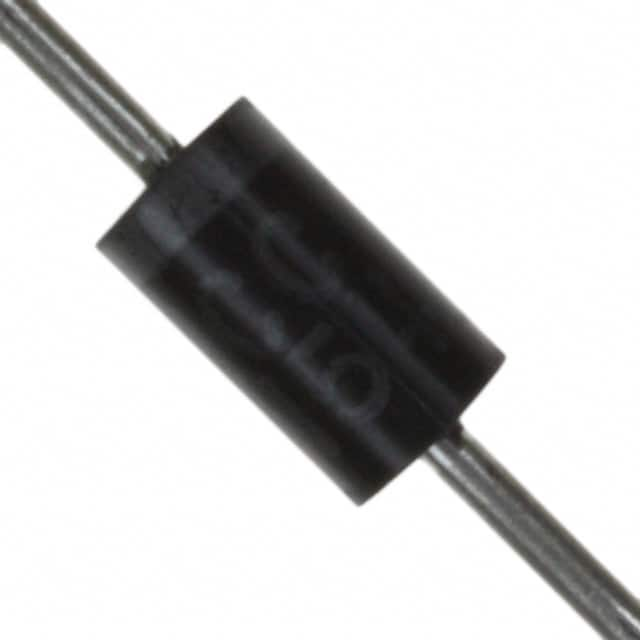1N5822-TP: Diode Rectifier
Basic Information Overview
- Category: Electronic Component
- Use: Rectification of AC to DC current
- Characteristics: High current capability, low forward voltage drop
- Package: Through Hole
- Essence: Efficient rectification of electrical current
- Packaging/Quantity: Typically available in reels or tubes containing multiple units
Specifications
The 1N5822-TP diode rectifier is a Schottky diode with a maximum average forward rectified current of 3A and a maximum repetitive peak reverse voltage of 40V. It has a low forward voltage drop typically around 0.45V at 3A.
Detailed Pin Configuration
The 1N5822-TP diode rectifier has two pins, the anode and the cathode. The anode is connected to the positive terminal of the circuit, while the cathode is connected to the negative terminal.
Functional Features
- Efficient rectification of AC to DC current
- Low forward voltage drop leading to reduced power loss
- High current capability allowing for handling of larger currents
Advantages and Disadvantages
Advantages
- Low forward voltage drop
- High current capability
- Fast switching speed
Disadvantages
- Limited reverse voltage capability compared to other diodes
- Sensitive to temperature variations
Working Principles
The 1N5822-TP diode rectifier operates based on the Schottky barrier principle, where the metal-semiconductor junction allows for faster switching and lower forward voltage drop compared to standard PN-junction diodes.
Detailed Application Field Plans
The 1N5822-TP diode rectifier finds extensive use in various applications including: - Power supplies - Voltage regulators - Solar panels - Battery charging circuits
Detailed and Complete Alternative Models
Some alternative models to the 1N5822-TP diode rectifier include: - 1N5817 - 1N5819 - SS34
In conclusion, the 1N5822-TP diode rectifier is a crucial electronic component known for its efficient rectification of electrical current, low forward voltage drop, and high current capability. Its application spans across various fields such as power supplies, voltage regulators, solar panels, and battery charging circuits. While it has certain limitations such as sensitivity to temperature variations and limited reverse voltage capability, its advantages make it a popular choice in the electronics industry.
[Word count: 358]
기술 솔루션에 1N5822-TP 적용과 관련된 10가지 일반적인 질문과 답변을 나열하세요.
What is the 1N5822-TP diode used for?
- The 1N5822-TP diode is commonly used as a rectifier in power supply circuits and voltage regulation applications.
What are the key specifications of the 1N5822-TP diode?
- The 1N5822-TP diode typically has a maximum forward current of 3A, a reverse voltage of 40V, and a low forward voltage drop.
How does the 1N5822-TP diode compare to other diodes in terms of performance?
- The 1N5822-TP diode offers lower forward voltage drop and higher current capability compared to standard silicon diodes, making it suitable for high-power applications.
Can the 1N5822-TP diode be used in switching power supply designs?
- Yes, the 1N5822-TP diode is often used in switching power supply designs due to its fast recovery time and low forward voltage drop.
What are the typical applications of the 1N5822-TP diode?
- Typical applications include DC-DC converters, voltage regulators, battery chargers, and reverse polarity protection circuits.
Does the 1N5822-TP diode require a heatsink in high-power applications?
- In high-power applications, it is recommended to use a heatsink with the 1N5822-TP diode to dissipate heat effectively.
What are the temperature considerations for the 1N5822-TP diode?
- The 1N5822-TP diode has a maximum operating temperature of around 175°C, so thermal management is important in high-temperature environments.
Can the 1N5822-TP diode handle surge currents?
- Yes, the 1N5822-TP diode is capable of handling short-duration surge currents, making it suitable for transient voltage suppression applications.
Are there any reliability issues associated with the 1N5822-TP diode?
- The 1N5822-TP diode is known for its reliability and ruggedness, making it a popular choice in industrial and automotive applications.
Where can I find detailed application notes for using the 1N5822-TP diode in specific technical solutions?
- Detailed application notes and design guidelines for the 1N5822-TP diode can be found in the manufacturer's datasheet and application guides, providing comprehensive information for various technical solutions.


